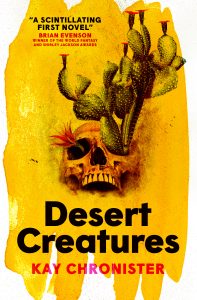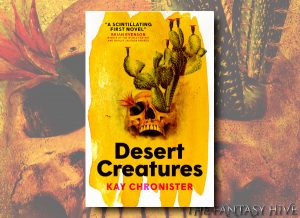DESERT CREATURE by Kay Chronister (BOOK REVIEW)
“The high desert was as she remembered. All the vegetation looking either hungry or glutted, plants with ribs and collarbones and heavy, pendulous bellies …
Only ones who could survive out there for long were them, drinkers said sagely across their cups of prickly pear wine, and the them was anything that partook in the sheer, raw strangeness of it. Animal or demon or unnamable atmosphere. Magdala didn’t know whether to count herself in that number.”
Kay Chronister’s Desert Creatures, first published in the US by Erewhon Books in 2022 and now published in the UK by Titan Books, is an absolutely remarkable debut novel that carves out new territory for the ecological weird. Chronister’s book boldly draws on everything from the bleak postmodern Westerns of Cormac McCarthy to the Canterbury Tales, and from genre fiction as diverse as Walter M. Miller Jr’s A Canticle For Leibowitz (1959), K. J. Bishop’s The Etched City (2003) and Aliya Whiteley’s The Beauty (2014). These comparisons hint at the novel’s visionary intensity and rich literary lineage, but Chronister’s vision is all her own. Full of hallucinogenic imagery, Desert Creatures relentlessly tracks its damaged characters’ ongoing search for redemption and transcendence across a desert world transfigured into a surrealist nightmare. Compelling, moving and unforgettable, Desert Creatures is a vital addition to the canon of the Weird.
 In a post-apocalyptic United States, a fire causes Magdala and her father Xavier to have to leave the relative safety of their shut-in community and wander the wastes of the Sonoran Desert in search of refuge. The desert is harsh and unforgiving, especially given they had no time to gather supplies, and Magdala’s clubfoot makes walking difficult for her. The fruiting cacti offer tempting relief from hunger and thirst, but can infect the careless with desert sickness, a syndrome linked to the destruction of the world that turns humans, cacti, and animals alike into shambling undead chimeras. The book is split into three sections. In the first section, Magdala and Xavier arrive at the settlement of Caput Lupinum, a ruthlessly run town which they and assorted refugees soon flee, trading stories that allegorize the fall of the world and their individual quests as they make the dangerous journey to the pilgrim road. In the second section, Magdala kidnaps an exiled heretical priest named Arturo and forces him to lead her to the Holy City of Las Vegas, so she can petition Saint Elkhanah’s holy bones to heal her disability. The third and final section follows Magdala years later after she has become a hitwoman for the brutal Deputy who controls Las Vegas, when she gets tired of killing for him and steals Saint Elkhanah’s bones and runs away from him, as the furious Deputy tries to track her down. Ultimately though, the mechanics of the plot take a back seat to Chronister’s wonderfully ambiguous characters’ thwarted attempts at redemption, striking and evocative nested stories that create contradictory future mythologies, and the harsh but beautiful ruined and mutated desert.
In a post-apocalyptic United States, a fire causes Magdala and her father Xavier to have to leave the relative safety of their shut-in community and wander the wastes of the Sonoran Desert in search of refuge. The desert is harsh and unforgiving, especially given they had no time to gather supplies, and Magdala’s clubfoot makes walking difficult for her. The fruiting cacti offer tempting relief from hunger and thirst, but can infect the careless with desert sickness, a syndrome linked to the destruction of the world that turns humans, cacti, and animals alike into shambling undead chimeras. The book is split into three sections. In the first section, Magdala and Xavier arrive at the settlement of Caput Lupinum, a ruthlessly run town which they and assorted refugees soon flee, trading stories that allegorize the fall of the world and their individual quests as they make the dangerous journey to the pilgrim road. In the second section, Magdala kidnaps an exiled heretical priest named Arturo and forces him to lead her to the Holy City of Las Vegas, so she can petition Saint Elkhanah’s holy bones to heal her disability. The third and final section follows Magdala years later after she has become a hitwoman for the brutal Deputy who controls Las Vegas, when she gets tired of killing for him and steals Saint Elkhanah’s bones and runs away from him, as the furious Deputy tries to track her down. Ultimately though, the mechanics of the plot take a back seat to Chronister’s wonderfully ambiguous characters’ thwarted attempts at redemption, striking and evocative nested stories that create contradictory future mythologies, and the harsh but beautiful ruined and mutated desert.
Desert Creatures is largely about redemption, and whether we or the novel’s characters are worthy of spiritual transcendence. I was a bit nervous about the trope of the disabled character on a quest for a magical cure for her disability, as it can be incredibly problematic when handled badly. But the magical cure held out in front of Magdala is a fake, like almost everything about the deeply cynical Holy Church of Los Vegas. Magdala’s disability is not a millstone, the removal of which is her reward for making it through the narrative; rather it’s just an aspect of her body and how she moves through the world that she has to live with, and her eventual redemption and spiritual transcendence have nothing to do with removing it, which the bones of Saint Elkhanah do not grant her anyway.
Instead, Desert Creatures is much more interested in whether Magdala, who lives in a brutal world and responds with brutality in order to survive, is capable of a more spiritual redemption. Magdala’s faith in a better world is thwarted at every opportunity. The world around her is harsh and unforgiving, and the surviving people who inhabit the Remainder, those left alive after the novel’s undefined apocalypse, frequently respond by becoming ever more harsh and unforgiving themselves. From the misogynistic men who run Caput Lupinum by branding the name of the men who “own” the women on the women’s necks, to the nihilistic bandits who capture Magdala and Arturo to ransom them to the Church, the desert is full of people who have turned to violence, abuse and hatred in order to survive. Others, like the grotesque desert cults who worship death and destruction, have turned to madness as the only way to make sense of this world. Magdala is just a child at the beginning of the book, yet in her short life has already experience horrific acts of violence and depravity, and frequently finds herself resorting to violence in order to survive. Yet there is another way. From the sacrifice Dulcinea, a young woman pilgrim who travels with Magdala from Caput Lupinum, makes so that Magdala can survive, to the peaceful ways of the cactus-sitters, mystics who have dedicated themselves to nonviolence and living with their transfigured world, to the magic of the saints who are able to comfort and salve the wounds of the world, many of the people Magdala encounters find more healthy ways to interact with others and their surroundings. Magdala’s personal journey sees her move through violence and despair to arrive at a more hopeful relationship to her place in the world.
All this is achieved against the startling backdrop of the vivid and hallucinogenic world Chronister has created. Chronister’s desert is infused with the dreamlike and the surreal, from the horrifying creatures that grow out of corpses of animals, plants and humans in the desert, to Araceli, a young girl who is able to transform people and things into different shapes. This is a land in violent flux, twisting itself into strange and frightening new shapes and configurations that defy humanity’s attempts to understand it. The only way they can do that is through the stories they tell themselves. The pilgrims on the road tell each other stories to pass the long desert nights, explanations for the transformation of the world that show how the apocalypse has become less a rational event and more a mythological remaking of the world. Some of the stories feature gods and spirits, whilst others show a world wrought by catastrophe in which the rich callously leave the poor to die, echoing the Covid pandemic and environmental catastrophes that are shaping our world at the moment. Either way, it is clear that humanity’s hubris, our arrogance and disregard for others and our world, are to blame. Other stories, like Arturo’s remembrance of his troubled past, his miraculous powers which he can nevertheless not control, and his conflict with the corrupt Holy Church, show how religion in the hands of the Church of Las Vegas has become a tool for social control, diametrically opposed to those who genuinely offer the people hope and salvation. Chronister weaves a rich tapestry of intertwining narratives which, even as they provide alternative explanations for the world of the novel, add thematic richness and depth.
Desert Creatures is a powerful and original work of speculative fiction. Chronister immediately marks herself out as a writer of skill, passion and imagination. Her novel is a striking new take on the post-apocalypse novel, invigorating an old genre tradition with new vitality and life. And it is a haunting meditation on what it means to retain our humanity under the most adverse of conditions. It is a masterpiece, all the more impressive for being Chronister’s debut. I eagerly look forward to whatever she does next.
Desert Creatures is out in the UK today from Titan Books. You can order your copy on Bookshop.org

